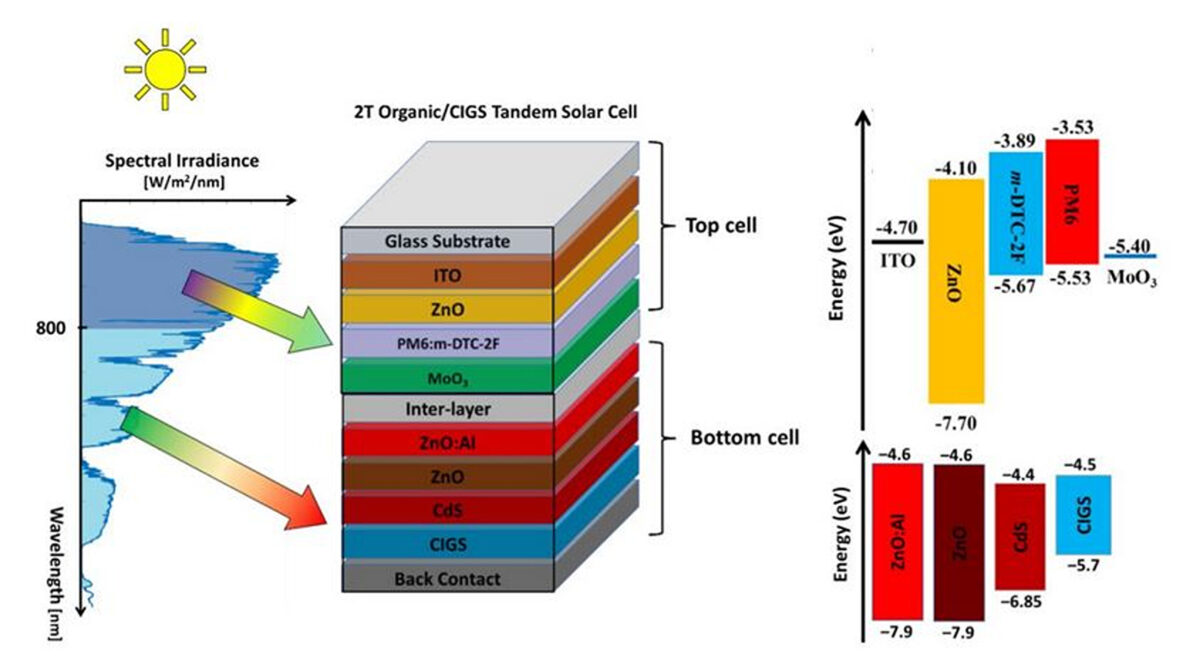An international research team has designed a flexible two-terminal (2T) tandem solar cell based on an organic top cell and a bottom cell relying on copper, indium, gallium, and diselenide (CIGS) technology.
The cell is intended for use in wearable applications.
“The constituent components of the tandem cell exhibit a complementary absorption profile,” the research's lead author, Mohamed Mousa Sayed Emam Ahmed, told pv magazine. “This characteristic ensures that the entire solar spectrum is effectively captured by the combined absorption capabilities of both subcells.”
The research group used the SCAPS-1D solar cell capacitance software, developed by the University of Ghent, to simulate the novel cell design. The latter includes a substrate made of indium tin oxide (ITO) and glass, the CIGS absorber, a cadmium sulfide (CdS) buffer layer, zinc oxide (ZnO), an aluminum-doped Zno (Zno-Al) optically transparent cathode, an interlayer based on transparent conductive oxides (TCO), a hole transport layer (HTL) made of molybdenum trioxide (MoO3), an absorber made with an organic material known as PM6:m-DTC-2 F, and another Zno layer.
Before defining the final cell configuration, the scientists tested 12 different HTL materials and different thicknesses for the two absorbers. “The rear subcell was improved by changing the doping level, which improves the subcell voltage and the overall tandem voltage and efficiency,” they explained. “The CIGS subcell doping levels were modified by increasing the doping of the CIGS film.”
Popular content
The simulation under standard illumination conditions initially achieved a power conversion efficiency of 22.5%. By further increasing the doping of the CIGS absorber and by optimizing the absorbers’ film thicknesses at 100 nm and 2.5 μm for the front and rear cells, respectively, the research group was able to raise the tandem device efficiency to 27.46%. It also achieved an open-circuit voltage of 1.89 V, a short-circuit current density of 17.55 mA/cm2, and a fill factor of 82.79%.
The organic cell and the CIGS device achieved an efficiency of 12.20% and 20.10%, respectively.
“The utilization of practical defect concentrations in absorber layers was key to achieve the 27.46% efficiency,” Ahmed said.
The novel cell design was presented in the study “Proposal and design of organic/CIGS tandem solar cell: Unveiling optoelectronic approaches for enhanced photovoltaic performance,” which was recently published in Optik. The research team comprised academics from the Future University and Ain Shams University in Egypt, as well as the Northern Border University in Saudi Arabia.
This content is protected by copyright and may not be reused. If you want to cooperate with us and would like to reuse some of our content, please contact: editors@pv-magazine.com.



1 comment
By submitting this form you agree to pv magazine using your data for the purposes of publishing your comment.
Your personal data will only be disclosed or otherwise transmitted to third parties for the purposes of spam filtering or if this is necessary for technical maintenance of the website. Any other transfer to third parties will not take place unless this is justified on the basis of applicable data protection regulations or if pv magazine is legally obliged to do so.
You may revoke this consent at any time with effect for the future, in which case your personal data will be deleted immediately. Otherwise, your data will be deleted if pv magazine has processed your request or the purpose of data storage is fulfilled.
Further information on data privacy can be found in our Data Protection Policy.